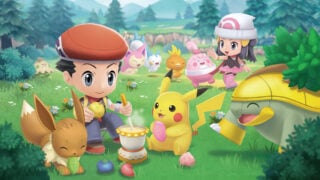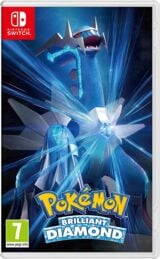Review: Pokémon Brilliant Diamond & Shining Pearl are faithful remakes, for better or worse
The improvements aren’t quite as drastic as hoped, but what’s here is a compelling Pokémon adventure regardless
- Co-director
- Yuichi Ueda
- Key Credits
- Junichi Masuda (Co-director), Shinya Suda (Program leader)

Chances are, the first Pokémon game you played is probably the one you have the most affection for, and no amount of logic or reasoning will convince you that it was anything other than the pinnacle of the series.
What can’t be argued, however, is that some of those classic games are starting to feel a little old hat, especially if you’re delving into Pokémon‘s back catalogue for the first time.
Brilliant Diamond and Shining Pearl is an attempt to recapture the magic of the 15-year-old DS games in a modern way that will also appeal to newcomers, and thankfully, the results are mainly successful.
Pokemon Scarlet and Violet Guides:
Pokemon Scarlet and Violet walkthrough, tips, and Pokemon locations | How to invite friends online Pokemon Scarlet and Violet | Pokemon type chart
Developed by prolific Japanese support studio ILCA, the game follows the same story beats as the DS versions, with players exploring the Sinnoh region as they attempt to defeat its eight gym leaders and obtain their gym badges, while also trying to fill their Pokédex for the slightly intense Professor Rowan.
If you’ve played any of the older Pokémon games, then, you’ll already know what to expect here in terms of the general structure. To be fair, if you’ve been sitting there hoping for a Pokémon game that will shake things up, a remake of a 15-year-old game wasn’t really going to be where that happened.
What has been completely overhauled, however, is the game’s visual style. While the DS original mainly consisted of sprite-based graphics with a few 3D-based environments thrown in, Brilliant Diamond and Shining Pearl are entirely polygonal.
What’s more, the game’s characters are now presented in an adorable ‘chibi’ style, with chunky big faces that look similar to EA’s old MySims franchise (just throwing that reference in there, in case the idea of a DS game being 15 years old didn’t make you feel ancient already).
At times the game is reminiscent of another Switch remake, Link’s Awakening, and while it doesn’t quite nail the same toy-like aesthetic, it still gives off a similar vibe with its cute characters, colourful landscapes and occasional surprisingly eye-catching effects (the water, for example, looks wonderful).
It doesn’t retain this art style the entire time, however. When you get into a battle, the game switches to the traditional over-the-shoulder viewpoint and the human characters change from the new chibi style to a more conventional look, similar to what we’ve seen in Pokémon Sword and Shield. Indeed, the battles look like they were lifted straight from that game with minimal changes made.
“When you get into a battle, the game switches to the traditional over-the-shoulder viewpoint and the human characters change from the new chibi style to a more conventional look, similar to what we’ve seen in Pokémon Sword and Shield.”
It can occasionally be a little jarring playing with one art style then immediately switching to a completely different one, but having said that it’s still faithful to the original game, which also had chunky characters in the top-down sections before switching to detailed sprites during battles. In that sense, then, it’s hardly a bold move.
Despite being based on the 2006 DS games, Brilliant Diamond and Shining Pearl still add some new features. Some of these are entirely new to the series, but most have been carried over from games that have subsequently been released over the past 15 years.
For example, ever since Pokémon Sun and Moon released on the 3DS, each game has shown players short messages during battles that tell them which moves are particularly effective against specific types of Pokémon. Although these weren’t in the original games, they’re in here.
Likewise, the DS titles didn’t allow you to customise your trainer’s appearance (probably because your character was a sprite) but it’s absolutely possible here, lending some variety that wasn’t present back in the day.
One of the most game-changing additions which has split the Pokémon fanbase in recent years is the way in which experience is shared. Throughout almost the entire history of the series, XP was only given to any Pokémon who were actually involved in a battle.
This changed when the series came to the Switch, with Pokémon Let’s Go Pikachu & Eevee and Pokémon Sword & Shield both revamping the system so that now all six Pokémon in your party get XP following a battle. Ever since the change was initially made we’ve seen some Pokemon diehards arguing that it ruins things, because it makes things easier, but we don’t agree.
We shudder to recall the hours lost in the original Diamond and Pearl constantly running back and forth through long grass to get into countless random battles, so we could grind the XP of all our party members. It wasn’t difficult, it was just a massive chore.
This newer method does away with that all together and as a result, players rarely have to grind at all. By simply taking on the wild Pokémon appearances and Pokémon trainer battles that are naturally encountered, your whole team grows organically and you’ll never really feel the need to double back and level up a specific Pokémon. Of course, anyone who’s played Sword & Shield will already have experienced this and will have their own opinion.
“By simply taking on the wild Pokémon appearances and Pokémon trainer battles that are naturally encountered, your whole team grows organically and you’ll never really feel the need to double back and level up a specific Pokémon.”
As for completely new features, most of the best stuff takes place underground. It was possible to dig underground in the original games, but this time the area is significantly larger and has been rather fittingly renamed The Grand Underground. It now has a similar shape to Sinnoh itself (to better put across the idea that you’re actually under that region) and includes a handful of new features that weren’t in the original games.
The best of these is the Pokémon Hideaways, which are special new areas where wild Pokémon are just roaming around. Some of these can’t be found anywhere else in Sinnoh, making it a great place to expand both your Pokédex and your team of six.
Rather than getting into random battles and waiting to see who you get, the Pokémon in the Hideaways are more like they are in the Let’s Go games – just wandering around on-screen. This means you can decide which Pokémon to actively engage with and which ones to ignore.

Once again, the hardcore may be turning their nose up at this because, like the XP sharing, it makes the game easier. Again, we disagree that this is a bad thing: this is a game that can last many hundreds of hours if you’re trying to complete it fully, and we’ll take any help we can get to speed that process up.
That said, we’d be lying if we said the expanded underground section and the other new features – such as replacing HMs with a Pokétch app that does the same thing – were truly revolutionary. They’re nice touches, but if you’ve already played the original Diamond and Pearl inside out we don’t think the new additions are expansive enough to transform your experience in any meaningful way.
There are other issues that we felt could have made the game even more enjoyable. Most of these are small things, but they happen frequently. The animation that plays when you get into a wild encounter is still quite long, for example, and when you’re roaming the long grass in an area in search of a specific species of Pokémon, running away each time you get the wrong one, these can all add up.
Similarly, the process when visiting a Pokémon Centre and getting your Pokémon healed is still a little longer than it needs to be. You still have to stand there and wait as all six Pokéballs are slowly loaded onto the tray, then wait as the music plays, then skip through the nurse’s dialogue each time.

And yes, as it did before, the game starts extremely slowly and assumes no prior Pokémon knowledge. It even does that really annoying thing where even if you catch a Pokémon early on, the game will completely ignore this and slowly teach you how to catch one anyway.
The quality of life improvements made to Brilliant Diamond and Shining Pearl make it a worthy remake of what was already a great instalment in the series.
Its new features may not be truly revolutionary, and it may still have its fair share of repetitive and time-consuming moments, but it’s a faithful take on a well-loved game, and should certainly keep players busy until Pokémon Legends: Arceus arrives in January.
The original DS Diamond and Pearl were great back in the day, and 15 years later this new coat of paint makes them just as entertaining. The improvements may not be as drastic as some may have hoped, but what's here is a solid Pokémon adventure regardless.
- Fantastic new art style
- Experience sharing from Sword & Shield is back
- The expanded underground section is welcome
- Filling the Pokédex is as compelling as ever
- The new features aren't enormously game-changing
















